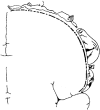The sensory cortical representation of the human penis: revisiting somatotopy in the male homunculus - PubMed (original) (raw)
The sensory cortical representation of the human penis: revisiting somatotopy in the male homunculus
Christian A Kell et al. J Neurosci. 2005.
Abstract
Pioneering mapping studies of the human cortex have established the notion of somatotopy in sensory representation, which transpired into Penfield and Rasmussen's famous sensory homunculus diagram. However, regarding the primary cortical representation of the genitals, classical and modern findings appear to be at odds with the principle of somatotopy, often assigning it to the cortex on the mesial wall. Using functional neuroimaging, we established a mediolateral sequence of somatosensory foot, penis, and lower abdominal wall representation on the contralateral postcentral gyrus in primary sensory cortex and a bilateral secondary somatosensory representation in the parietal operculum.
Figures
Figure 1.
The sensory focus of the penis lies lateral to that of the toe. Significant fMRI activations (see Materials and Methods) in the right primary somatosensory cortex after stimulation of the contralateral hallux (red), prepuce or glans (green), penile shaft (blue), and lower abdominal wall (cyan in subjects 5-8) are overlaid onto each individual's anatomical scan. The square depicts the Rolandic template for analysis of primary sensory cortex, and dotted lines mark the central sulcus.
Figure 2.
Stimulation of the toe and penis leads to contralateral primary somatosensory and bilateral activation in the opercular secondary somatosensory cortex. Random effects group results were significant at p < 0.001 (uncorrected), but activations were thresholded at p < 0.006 for better visibility when projected onto a template-rendered brain. Red and green signify activations related to toe and prepuce. On the single-subject level, most activations reached a significance of p < 0.05, corrected for multiple comparisons within the delineated opercular template volume (dashed lines).
Figure 3.
A modified version of Penfield and Rasmussen's sensory homunculus.
Similar articles
- Functional architecture of the somatosensory homunculus detected by electrostimulation.
Roux FE, Djidjeli I, Durand JB. Roux FE, et al. J Physiol. 2018 Mar 1;596(5):941-956. doi: 10.1113/JP275243. Epub 2018 Jan 19. J Physiol. 2018. PMID: 29285773 Free PMC article. - Dermatomal Organization of SI Leg Representation in Humans: Revising the Somatosensory Homunculus.
Dietrich C, Blume KR, Franz M, Huonker R, Carl M, Preißler S, Hofmann GO, Miltner WHR, Weiss T. Dietrich C, et al. Cereb Cortex. 2017 Sep 1;27(9):4564-4569. doi: 10.1093/cercor/bhx007. Cereb Cortex. 2017. PMID: 28119344 - Somatotopy in human primary somatosensory cortex in pain system.
Ogino Y, Nemoto H, Goto F. Ogino Y, et al. Anesthesiology. 2005 Oct;103(4):821-7. doi: 10.1097/00000542-200510000-00021. Anesthesiology. 2005. PMID: 16192775 - Edwin Boldrey and Wilder Penfield's Homunculus: A Life Given by Mrs. Cantlie (In and Out of Realism).
Gandhoke GS, Belykh E, Zhao X, Leblanc R, Preul MC. Gandhoke GS, et al. World Neurosurg. 2019 Dec;132:377-388. doi: 10.1016/j.wneu.2019.08.116. Epub 2019 Aug 27. World Neurosurg. 2019. PMID: 31470165 Review. - [Somatotopy and information processing in the somatosensory cortex].
Iwamura Y. Iwamura Y. Brain Nerve. 2009 Dec;61(12):1373-82. Brain Nerve. 2009. PMID: 20034304 Review. Japanese.
Cited by
- Neuroimaging and sexual behavior: identification of regional and functional differences.
Cheng JC, Secondary J, Burke WH, Fedoroff JP, Dwyer RG. Cheng JC, et al. Curr Psychiatry Rep. 2015 Jul;17(7):55. doi: 10.1007/s11920-015-0593-x. Curr Psychiatry Rep. 2015. PMID: 25980508 Review. - Non-topographical contrast enhancement in the olfactory bulb.
Cleland TA, Sethupathy P. Cleland TA, et al. BMC Neurosci. 2006 Jan 24;7:7. doi: 10.1186/1471-2202-7-7. BMC Neurosci. 2006. PMID: 16433921 Free PMC article. - Doing it … wild? On the role of the cerebral cortex in human sexual activity.
Georgiadis JR. Georgiadis JR. Socioaffect Neurosci Psychol. 2012 Mar 15;2:17337. doi: 10.3402/snp.v2i0.17337. eCollection 2012. Socioaffect Neurosci Psychol. 2012. PMID: 24693348 Free PMC article. - PIEZO2 and perineal mechanosensation are essential for sexual function.
Lam RM, von Buchholtz LJ, Falgairolle M, Osborne J, Frangos E, Servin-Vences MR, Nagel M, Nguyen MQ, Jayabalan M, Saade D, Patapoutian A, Bönnemann CG, Ryba NJP, Chesler AT. Lam RM, et al. Science. 2023 Aug 25;381(6660):906-910. doi: 10.1126/science.adg0144. Epub 2023 Aug 24. Science. 2023. PMID: 37616369 Free PMC article. - Single subject and group whole-brain fMRI mapping of male genital sensation at 7 Tesla.
Luijten SPR, Groenendijk IM, Holstege JC, De Zeeuw CI, van der Zwaag W, Blok BFM. Luijten SPR, et al. Sci Rep. 2020 Feb 12;10(1):2487. doi: 10.1038/s41598-020-58966-9. Sci Rep. 2020. PMID: 32051426 Free PMC article.
References
- Allison T, McCarthy G, Luby M, Puce A, Spencer DD (1996) Localization of functional regions of human mesial cortex by somatosensory evoked potential recording and by cortical stimulation. Electroencephalogr Clin Neurophysiol 100: 126-140. - PubMed
- Bradley WE, Farrell DF, Ojemann GA (1998) Human cerebrocortical potentials evoked by stimulation of the dorsal nerve of the penis. Somatosens Mot Res 15: 118-127. - PubMed
- Eickhoff SB, Stephan KE, Mohlberg H, Grefkes C, Fink GR, Amunts K, Zilles K (2005) A new SPM toolbox for combining probabilistic cytoarchitectonic maps and functional imaging data. NeuroImage 25: 1325-1335. - PubMed
- Feinsod M (2005) Kershman's sad reflections on the homunculus: a historical vignette. Neurology 64: 524-525. - PubMed
- Foerster O (1936) Sensible corticale Felder. In: Handbuch der Neurologie. Berlin: Springer.
Publication types
MeSH terms
LinkOut - more resources
Full Text Sources


